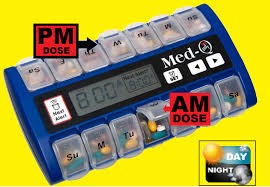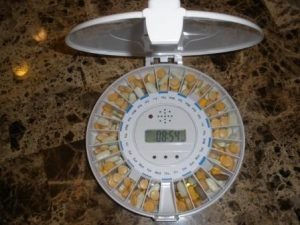5.1. Medications remainder boxes (MRB)

Not taking prescribed medication – noncompliance – can have serious health consequences. The reasons why people forget or don’t take medications are varied. Maybe the doctor didn’t explain how to take it properly. Maybe they feel better and think they don’t need the medicine anymore. Maybe they just forgot.
Medication Reminder Box (MRB): a container that is compartmentalized and designed to hold medications for distribution according to a time element such as day, week, or portions thereof.
A pill organizer, pill container, or pillbox is a special container for storing scheduled doses of one’s medications. Pill organizers usually have square-shaped compartments for each day of the week, although other more compact and discreet versions have come to market, including cylindrical and pen-shaped cases. Some organizers have multiple sections, corresponding with different times of the day. Pill organizers are viewed as a way to prevent or reduce medication errors on the part of the patient.
MRBs are useful for all types of clients, including the elderly, those who have memory deficiencies, and those taking multiple medications, as an aid in remembering to take proper doses of their medications thereby complying with their doctor’s recommended dose, allow a patient to know whether or not they have taken a particular dose of their medication; if a pill still remains in its compartment, it is apparent that it has not yet been taken, whereas if it is missing, it has already been taken.
MRBs often have various features to make them easier for special-needs patients to use, such as color-coding, Braille for the blind, or a locking mechanism to prevent double dosing.[ Some organizers used for diabetes patients have sections for insulin and hypodermic syringes.
Some QMAPs will pre-load pills into pill organizers for their patients, as a convenient service
The most common type of medication system is the simple box with slots for different times of day. Caregivers sort out medications generally up to one week in advance and place it in the correct slot. At the appropriate time, the patient or the caregiver can tell at a moment’s glance which medicines need to be taken when.

Electronic pill organizers, pill dispensers, and pill reminders have been developed that alert patient when their prescription medication, OTC medication, or daily food supplements must be taken. These devices have been credited with saving lives and saving money in the health care system. Advanced models can be linked via the Internet to a medical facility, to aid in monitoring and reminding a client to take his/her medications. MRB with electronic alarms can look similar to an alarm clock and have settings for several different medications. These need to be programmed in advance by the caregiver so that the client is not easily confused by the device. One alarm vibrates strong enough when placed inside a pillowcase that it will wake the client to remind them that they need to take medication.

- MRB’s can be filled up to fourteen (14) days in advance. Successful completion of this course allows QMAP to fill MRB’s with supervision by a licensed professional or qualified manager. Regulations also allow medication reminder boxes used in designated facilities to be filled by the client, the family or a friend.
- There must be a complete label firmly attached to the box. This requires the name of the client, the name of each medication, dosage, quantity, route, and the specific time that each med is to be administered. If the design of the box does not permit firm attachment of the complete label, the MRB cannot be used by the QMAP.
- There must be a MAR for recording all drugs placed in the MRB and monitored or administered by staff. A client “self-administering” medication may fill his/her own MRB and utilize this method for storing medication prior to taking his/her medication. Medications that are “self-administered” from a MRB must be properly labeled but do not need to be documented on a MAR.
- If there is a physician ordered the change in the client’s medications, the facility must stop the use of the MRB until the designated QMAP, nurse or family member/friend has corrected the MRB according to the new order.
Certain medications may not be placed in a MRB:
- – Controlled substances;
- – PRN medications;
- – liquid medications;
- – medications with special instructions, such as “30 minutes prior to lunch”;
- – powders, inhalers, ointments, and creams.
- Ø QMAP’s “shall be familiar with the type and quantity of medication in each compartment of the box.” If the QMAP suspects that the tabs/caps in the MRB are not consistent with the label on the MRB the QMAP administering medications must not proceed with the administration of medications from the MRB until the problem is resolved.
- Ø The QMAP should not correct the discrepancy; a licensed person, qualified manager or the QMAP who filled the MRB should resolve difference(s).
A qualified medication manager must oversee a QMAP filling a MRB. The qualified manager should check the filling of the MRB’s weekly during at least the first two (2) times the MRBs are filled by a new QMAP, or by a QMAP who is a new employee and periodically thereafter. A qualified manager must be available for consultation whenever a MRB is being filled.